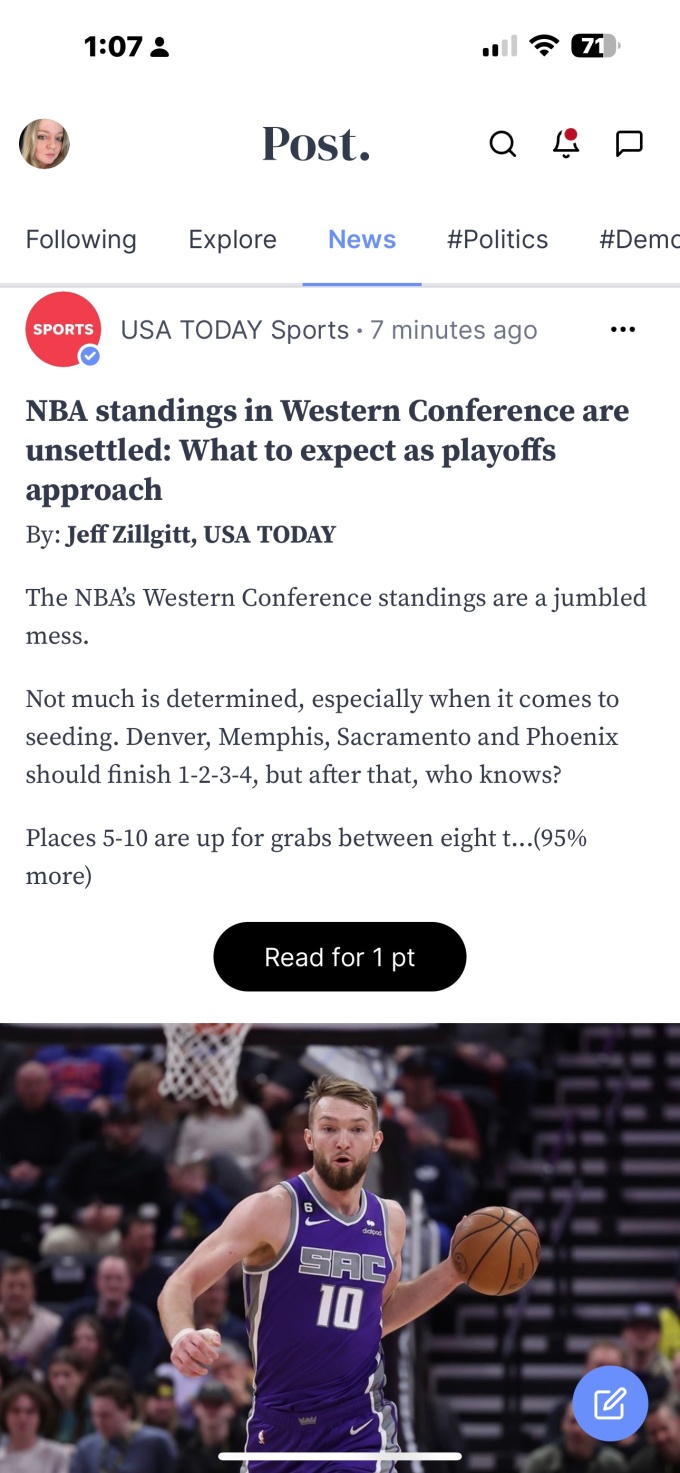After, a sort of Twitter alternative that rethinks how publishers should engage with social media — and monetize their readership — has opened its doors to the public. The startup, like others in this space, gained ground following Elon Musk’s takeover of Twitter, as many began looking for a new place to read and discuss the news or share their own thoughts with their followers. But Post doesn’t want to be just another Twitter clone. Instead, the goal is to develop a platform where publishers can monetize micropayments, that is, where users pay a small amount to read individual news items.
These can be articles from traditional media outlets that would otherwise be behind a subscription-based paywall, but they can also be other types of media, such as subscription newsletters, or even free and ad-supported content offered elsewhere. The latter has been the source of some criticism for Post, along the lines of “Who would pay for news you could get for free elsewhere?”
But that response conveniently forgets about the miserable experience of reading free news on today’s web.
Ads and internal promos are everywhere – even in the middle of articles as you scroll down. Videos play automatically, often in their own pop-up windows. Cookie consent banners appear, attempting to trick you into agreeing to hand over more data. Prompts to purchase a subscription or sign up for the publisher’s newsletter appear at the top of the screen, forcing you to ignore them.
Explains the founder and CEO of Post Noam Bardinformerly CEO of Waze at Google, Post’s partner publishers have already found that users want to read news in their feed rather than jumping to external websites – even if it’s more expensive to do so.

Image Credits: Post screenshot
“You visit a lot of news sites these days and you are bombarded by these advertisements, email capture forms and subscriptions… you only wanted to read one article. And you wanted to read it because someone shared it. So a one-off transaction, but you are bombarded,” he says. “We believe that with a great user experience, the right pricing and no friction, we can bring a new business model to the world of advertising. [or] subscription.”
Bardin tells businesskinda.com that when they spoke to publishers, they generally agreed with the startup’s contention — that its current subscription structure, outside of The New York Times and The Wall Street Journal — isn’t good for publishers. They recognized that social media stock website traffic doesn’t often convert visitors into subscribers and that subscribers make up only a fraction of their larger readership.
“Everyone agrees there is a problem. Nobody wants to be first,” he says, speaking of Post’s initial struggles with publisher adoption.
The Post website itself first launched in November 2022 in a closed beta that grew to 650,000 people on the waiting list. Of these, 430,000 people have actually created an account. Then publishers took notice.
As Post now enters its public beta period, Twitter is determined to anger publishers by stripping their Verified badges if they don’t pay. Post instead offers to pay publishers. That has some features. The company has 25 premium publishers on board today and several hundred in various stages. Some, such as local news publishers, are waiting for additional functionality to be added to the platform.
At launch, Post signed up partners including The Boston Globe, The Brookings Institution, Fortune, The Independent, Insider, LA Times, NBC News, Politico, ProPublica, Reuters, Semafor, SF Chronicle, MIT Technology Review, USA Today, Wired, World Politics Review and Yahoo Finance.

Image Credits: Post screenshot
Some of these outlets post manually, while others are experimenting with micropayments, and some do both. Those who have tried the micropayment option include Fortune, The Independent, LA Times, Reuters, MIT Technology Review, USA Today, and Wired.
Bardin claims the average CPM publishers get from Post’s platform is $25 for a paid post. The top article received a $300 CPM. But, he adds, publishers also earn an average of $1.30 CPM from their free posts through donations and tips.
The Post Users micropayment platform, powered by Stripe, allows users to purchase a bundle of points in packs ranging from 300 ($4.20) to 10,000 ($126.70). As you get into the higher tiers – 1,500, 5,000 or 10,000 points, you get a discount on your purchase. Post generates revenue by taking a small percentage of these sales, similar to Twitch.

Image Credits: Post screenshot
Bardin doesn’t share Post’s current active user numbers, but says that when people stopped getting 50 free points when signing up, 80% entered their credit card information to buy more. That’s a promising number, but it’s still early days for this startup. After all, Twitter never gained mass market appeal and Twitter alternatives have an even tougher hill to climb as they try to attract a mainstream user base.
What a publisher chooses to charge for their articles is up to them – we saw just 1 point (see image on the right) and even 89 points when scrolling through our feed. Post plans to add other payment options over time, such as “pay what you want” (which can also mean nothing, if you want), a “buy one, share one” option, and an option where the first few articles per month are free.
The site, similar to pre-Elon Twitter, has that too a number of rules regarding user behaviour. It will kick people out for breaking them, but doesn’t yet know how it will draw the line between temporary and permanent bans. The “freedom of speech” approach – an issue of much consternation in the Elon era – is quite simple.
“When it comes to people, you have no right to be an asshole. That is not a God-given right in the Constitution. So if you want, go elsewhere. We don’t need you. You don’t have to be an asshole here.”
In addition, Post wants to use AI technologies to personalize the news feed for its end users – an idea that is now also being trialled by Artifact, the news app from Instagram’s co-founders. Post also expects that, as a news feed experience, many of its users won’t be active content creators themselves. In fact there is one old internet adage that says most people on a service are consuming content but not participating or creating it. Yet that vast majority is often forgotten when building services.
They don’t publish. You don’t hear them,” says Bardin. But, he adds, “they are the audience in many ways.”
“Seventy-five percent of Twitter users have never tweeted,” he continues. “People use it to consume information, but it’s built for the people who create the information…there are a lot of things I think we all would have done differently with Twitter if we started today.”
Post’s service as it stands today reflects that philosophy. It’s more of a place to scroll and read the news, but lacks the active conversations about the news that happen on bigger platforms like Twitter, or even newer alternatives like T2 or Mastodon. But that involvement may come in time, as Post plans to eventually adopt ActivityPub – the protocol that powers the open source, decentralized Mastodon and the wider Fediverse. As an interconnected app, Post could be used more actively.
“We started building on Mastodon… We love what Mastodon does,” Bardin tells us. “And Bluesky is a different approach, but the same concept,” he says. “We will add integration with Mastodon and others.”
That’s much further down the road – it’s not in the works for 2023, we understand.
“We just started the business in May. We’re not even a year old. We have a lot of things we want to do – we don’t want to limit ourselves to supporting other protocols at this stage. Once we build the core and like it, we can see exactly how these protocols can or cannot be connected,” says Bardin.
Post quietly dropped the invite requirement a few weeks ago, but hadn’t yet formally announced the launch of the public beta.
While the startup is not talking about active use, the site saw its traffic spike with more than 5.19 million monthly visits in December 2022, according to data from Similarweb. That has since dropped to 921,000+ visits by March 2023 (as of March 27). The company estimates that Post had a total of about 946,120 daily users over the past 28 days. Not bad for the crowded alt-Twitter market these days, where Mastodon now has 1.2 million monthly activesfor comparison.
Based in New York with a distributed team of 20, including co-founder Noel BaronPost increased a seed round of Andreessen Horowitz (a16z), as well as Scott Galloway, an NYU professor and technical commentator. Silicon Valley journalist Kara Swisher as well said she advises the startup. The company is not currently increasing, but is hiring.
Janice has been with businesskinda for 5 years, writing copy for client websites, blog posts, EDMs and other mediums to engage readers and encourage action. By collaborating with clients, our SEO manager and the wider businesskinda team, Janice seeks to understand an audience before creating memorable, persuasive copy.















